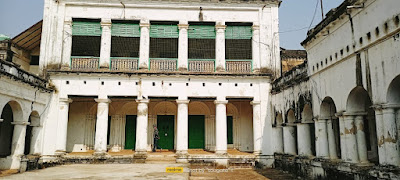Travelling not only means going from one place to another, typically over a distance of some length, but also intermingling with people from different spheres of life. I have always been an ardent admirer of travelling and often tend to throw myself beyond my comfort zones. Here in this blog, I would like to narrate one of my recent visits to Patashpur where not only the natural beauty but also the warmth of the people living there amazed me in every possible way.
Patashpur is a town in Egra subdivision of Purba Mediniplur district (or East Midnapore, as some of us may call it) situated in West Bengal. According to the historians, the Bargis (Maratha Warriors) ruled in Pastashpur for many years. At that time Patashpur was not under Medinipur district. In 1760, Medinipur district came under the control of the East India Company. The Bargis used Patashpur as a base for looting the Medinipur area. In 1803, Odisha along with Patashpur came under the control of the British government. I felt privileged getting a chance to visit a tiny village in such historical Patashpur when one of my close friends, Sougata Jana, invited me to attend his elder brother's wedding on 11th December, 2021. I happily accepted his invitation and set forth to his native village, Chak Srikrishna. This time our team consisted of Swarup, Bubun (Sougata's cousin) and myself.
 |
| Team Patashpur... |
According to the plan we started our journey to Patashpur on 11th December, 2021. We boarded Kharagpur local from Howrah station at around 7:20 A.M and reached Balichak at around 9:40 A.M. On arrival at the Balichak station we had our breakfast before boarding a local bus and set forth to Chak Srikrishna village. We comfortably placed ourselves on the roof of the bus and the ride, needless to say, turned out to be a joyride.
 |
| Whatever makes your soul happy do that... |
When we reached Chak Srikrishna it was already 1:30 P.M. Sougata and his friends were waiting at the bus stop to receive us. From the bus stop it was another 7-8 kilometres of motorcycle ride to Sougata's house. This stretch of 7-8 kilometres cuts through many paddy fields which had already grown golden in colour with ripened seeds. The view of those golden rice fields was breathtakingly beautiful. I would like to take this opportunity to request my readers to visit remote villages in West Bengal or in any part of the country, once in a while with their children so that they can get acquainted with natural elements like, golden paddy fields, muddy roads, domestic cattle and above all the hardship of a farmer's life. True essence of life is not complete unless one visits a village in person.
I was overwhelmed by the kind of reception I received from Sougata's family members. I personally feel that the hospitality of villagers is far more warmer than that of the people in metro cities. We quickly freshened up and had our lunch. The marriage ceremony was scheduled in late evening. After lunch we chatted for long hours with the hosts. Here, I got the information about the age-old Raghunath temple situated in the locality. According to the locals it is believed that the temple was built by the then Zamindars (Chowdhurys) of the locality in the sixteenth century. They were staunch followers of Lord Vishnu and had set up numerous temples throughout their territory. The marriage ceremony though simple in stature was held in great joy and grandeur.
 |
| The groom is like a flower of gold. When he walks, blossoms at his feet unfold... |
Up you see an image of the Groom sitting with his half groom (or nephew). The reception party was scheduled to be held on 12th December, 2021. It was a busy day for the hosts so I didn't get much time to interact with them. At the reception party, Sougata's father introduced me to the present descendant of the Zamindars' of Patashpur. He is a very humble person and gave me a brief overview of the rich cultural and historical importance of his family. I was overwhelmed by the way he tried to uphold the legacy and heritage of his family alongside the place and couldn't refuse his offer to visit his palace at Pochet Garh in person. That day after the reception got over I had a long conversation with Sougata's relatives listening to their anecdotes. Next day Swarup left early in the morning as he had to attend his office. I along with Sougata and Arpan (Sougata's friend) visited the Pochet Garh Palace.
Pochet Garh Palace has rich cultural and historical importance. The palace has been recently declared as a heritage site. The manager of the estate accompanied us and illustrated the historical importance attached to it. Being a fond lover of history I enjoyed his briefing thoroughly. We were completely engulfed in the magnificence and ambience of the palace.
 |
| Pochet Garh Palace... |
That night after returning from the palace Sougata and I conversed for long hours reflecting on what we witnessed in the palace, our lives so far and where we see ourselves in the coming future. My time at Patashpur was nearing to end. Next morning i.e., on 13th December 2021, I left for Kolkata. Not only the captivating history of Patashpur left a deep imprint in my mind but also the warm reception I received from Sougata's family touched my soul. The memories of this trip shall continue to live with me for as long as I keep travelling different places throughout my life.
Until next time...
(Picture Courtesy: Sougata Jana)










